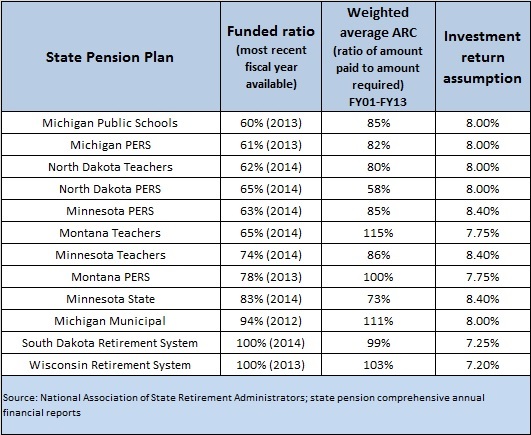Will pension funds have enough money to pay off their plan’s retirees? Each pension fund has a portfolio of investments (assets) and a current value of future pension payouts (liabilities). The pension fund is considered well-funded if the assets exceed the liabilities. An easy gauge of pension health is the funded ratio, which is the assets divided by the liabilities (see table).
Most pension funds in the Ninth District are underfunded, with the Michigan Public School Pension having the lowest funded ratio at 60 percent, with unfunded liabilities of $26 billion. One way to remedy the underfunded problem is for government employers to kick in more money (via public tax dollars). The employer contribution necessary to eventually make a pension fund whole is called the annual required contribution (ARC) and is determined in part by related employee contributions and investment returns.
Employee contributions are typically a set percentage of salary or wages. Investment returns are gauged against return assumptions, which range from 7.2 percent to 8.4 percent for different plans (see table). Higher investment assumptions lead to lower employer contributions (and therefore lower ARC), at least initially. But failure to meet investment assumptions creates unfunded liabilities, which raises ARC over time; the higher the investment assumption, the greater the unfunded liabilities when returns are low.
The National Association of State Retirement Administrators (NASRA) recently released a report analyzing state public pension plans from 2001 through 2013, comparing actual government contributions to the annual required amounts. The results show a range of disparities across Ninth District states (see table). Some states have one unified system while others have separate plans for teachers or other public employees. Wisconsin’s annual contributions exceeded ARC by three percent over this 12-year period, while government contributions for the North Dakota Public Employees Retirement System were 42 percent below the ARC.
Underfunded plans are occurring despite the fact that actual government contributions have been rising steeply for many government employers. For example, school districts in the Michigan Public Schools plan have seen their actual contributions rise from about $600 million in 2001 to almost $1.4 billion in 2013, according to the NASRA report. Over this same period, the annual required amount has risen from about $600 million to almost $2 billion.
Research Analyst Dulguun Batbold contributed to this article.






